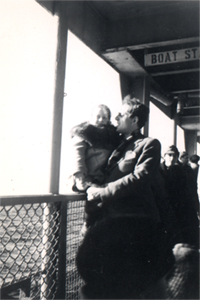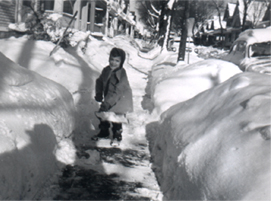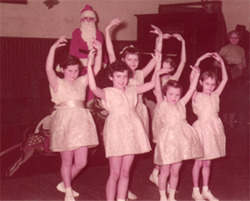Family history, musical roots•
• My mother, granddaughter of Baron Ludwig von Nolcken, was born in Kiev in 1922. Her paternalgrandfather, Andrey Alexandrovich Aristov, was Commandant of the city of Kiev before the revolution; his son Andrey Andreyevich, mother's father, was a soloist at the State Opera Theater in Kiev. My mother and both my grandmothers were pianists. My father's paternal ancestors – the Brockerts – were ethnic Germans, who emigrated to Odessa from East Prussia toward the end of the 19 th century.
|
 |
|---|
• Being the daughter of an opera singer, my mother often invited singers to our house, whom she accompanied on the piano. I thus became familiar with Russian operatic and song literature, including arrangements of folk songs.
• My mother was also the accompanist for the Ukrainian male vocal quartet Niagara Troubadours, with whom she went on concert tours. The rehearsals were held in our home.
My first – and only – piano teacher (until I left home to go to college) was my mother. Our family participated actively in the Russian Orthodox community. We children attended “Russian” school, went to scout camp in the summer, performed songs and dances at parish events and at the International Institute.
Education, Folklore Studies
• My intense involvement with Russian folklore began while I was in college at Bryn Mawr, where I studied with the distinguished musicologist Professor Alfred J. Swan, and continued in Bloomington with the eminent folklorist Professor Felix J. Oinas. It was during this time that I discovered my passion for folk dancing, which has remained with me to this day. In Philadelphia and in Bloomington I joined the folk dancing communities, learning dances from the Balkans, Russia, Turkey, Israel … from such inspiring teachers as Dick Crum. In Berlin in the 1970's my friendships with Turkish, Iranian and German musicians and dancers evolved into long and intense collaborations, expanding my experience as a dancer, instrumentalist (piano, accordion, hammered dulcimer, xylophone, washboard), singer, choir director and arranger.
While researching for new material in phono archives, I became enchanted by field recordings of Russian village singers. Nothing I had heard before touched me as deeply and lastingly.My growing preference for singing these heart-opening ancient songs in the traditional manner met with resistance within the group, so that I have kept the most beautiful stylised folk songs in the repertoire, taking great care to distill them to their essence in my careful arrangements. Singing in the authentic strong and direct manner requires a conscious inner effort to open oneself; only then will this music reveal its profound richness. Since song and dance form an indivisible whole in Russian village music, I was very fortunate to find a dance teacher, Hennie Konings, who gathered his material from authentic sources.
• Since the 1980's I've travelled frequently to Russia, my family's ancestral homeland. In 1995 the Perepyolochki were honored by an invitation to the 6 th International Folklore Festival in Archangelsk, North Russia. It took tenacious persuasion on my part to convince the organizers of the festival, who were expecting us to sing German songs, that our vocal ensemble of women from Berlin, Germany sang exclusively in Russian! Participating in the festival were peasant singers from remote Russian villages, many of whom became “my grandmothers” and a source of inspiration to this day.
• On two occasions the ensemble Perepyolochki travelled to the USA and Canada on concert tours: in 2000 for my father's 80 th birthday and 2002 to celebrate my mother's 80 th .
Costumes
• For centuries the Russian peasantry has kept village cultural traditions alive by handing them down to the next generation. Folk songs, dances, rituals and traditional costumes have thus been preserved for future generations to cherish. The enormous variety and richness of peasant festive clothing give evidence of superb workmanship and virtuosity of design. Deep meaning permeates each ornament: intricate embroidery, dazzling glass beadwork, gold thread lace trimming … As a visual expression of peasant worldview and beliefs, the traditional costume reflects the spirit of peasant songs. For a singer seeking credibility when performing songs of a foreign culture, “slipping into a stranger's skin” (i.e. identity) by putting on a traditional costume can enhance the feeling of transformation, but only if the costuming is performed as a conscious ritual, and the costume itself has been sewn with loving care and faithful attention to detail. I set my heart on creating a costume collection for the Perepyolochki that would be an inspiration to the singers, enriching the singing experience and intensifying identification with the “folk” whose songs we sing. I immersed myself totally in research and the search for fabrics and ornamental materials based on original costumes in museum collections. My first set of costumes (two-piece “parochki” in the style of the Archangelsk region) were completed just in time for the folklore festival, where they caused great awe and amazement among the singers from the North-Russian villages of Leshukonskoye and Keba, whose traditional festive costumes were made of the same silk fabric as ours. They couldn't believe their eyes: “They're wearing our dresses and singing our songs!”
• At the festival I met village singers from many different regions of Russia, some of whose costumes were more than a hundred years old. They were incredibly well-preserved – a veritable visual and tactile feast! From that moment on I knew I would dedicate myself to recreating the most beautiful costumes from different regions of Russia. But first I needed to find the perfect seamstress to carry out the project. How fortunate I was to meet Svetlana Nozikova, an expert on textile restoration, who had worked at the Museum of Regional Studies in Archangelsk (and later in St. Petersburg restoring vestments). Her “golden hands” have recreated folk costumes from the Voronezh, Oryol, Ryasan', Kaluga and Moscow regions and traditional clothing of the Russian Orthodox Old Ritualists from the Lake Baikal region (www.Perepjolotschki.de).
Sacred Music
• In Stratford, Connecticut, where we lived since 1961, my father was President (Starosta) of St. Nicholas Russian-Orthodox Church. My mother sang in the choir, and whenever I visit Stratford, we sing together in church. Actually, my relation to Orthodox music is a genetic one: my maternal ancestors, the Aristovs, were Greeks who set out in the 10 th century to convert Russia to Christianity. Since 1998 I have been teaching Russian Orthodox chant and performing with the Capella Russica in churches throughout Berlin (www.CapellaRussica.de). In 2002 I attended the Summer School of Liturgical Music at Holy Trinity Seminary in Jordanville, N.Y.
• Soon afterwards I discovered the American Sacred Harp shape-note singing tradition. Like Russian Orthodox chants, Sacred Harp hymns are sung a cappella with powerful hard-edged voices that rise from the depths of the soul toward the skies, creating the exhilarating feeling of “Heaven on Earth”. In 2004 I founded a singing school for American sacred song and traditional folk music ( www.BerlinShapeNote.de). With my vocal ensemble Far Afield and the bluegrass bands Ken & Tucky and Bluegrass Mountain, I've been able to dedicate myself to keeping this rich tradition alive.
A perplexing question: How do I perceive myself?
• There seems to be no clear-cut answer. I am a soul divided, not only in two, but in three parts. Every trip to America is a “coming home”; in Russia I feel “at home” as well. The East and the West – both are dear to my heart. And Berlin - is it merely a point of departure, a “waiting room”, or the center where I find equilibrium? Here in “Old Europe” I miss my loving family in the States; when in America, I long for the lost Russian homeland and my dear relatives who live there. It is through singing traditional folk songs (the Russian and the American), however, that I “become whole” again. Here I have found a panacea, my life's work and destiny. In the ancient songs the memory of past generations is stored – like a genetic code waiting to be brought to life. In singing I become one with my ancestors, with all whoever lived on this earth. That which geographically could never be united, comes together through song: the lost, the forgotten – my unlived lives. This is the quintessence of folk songs' power: to reveal that place in each of us, where we are all the same – not Russians, not Americans – simply humans. All traditional music has this power when freed from kitsch, from stylisation, when left in its authentic form.


